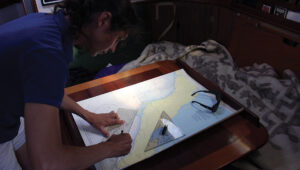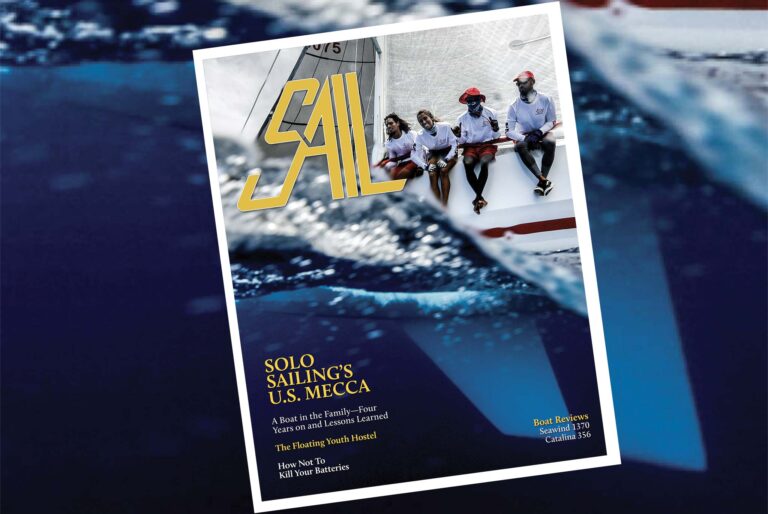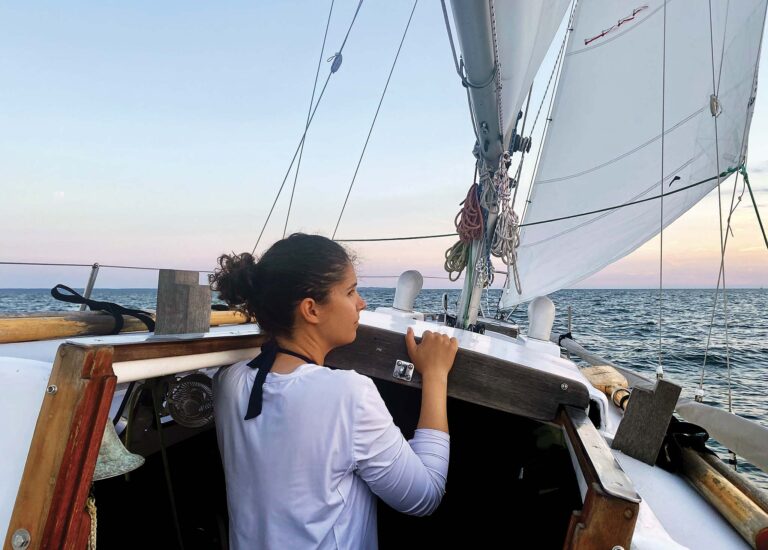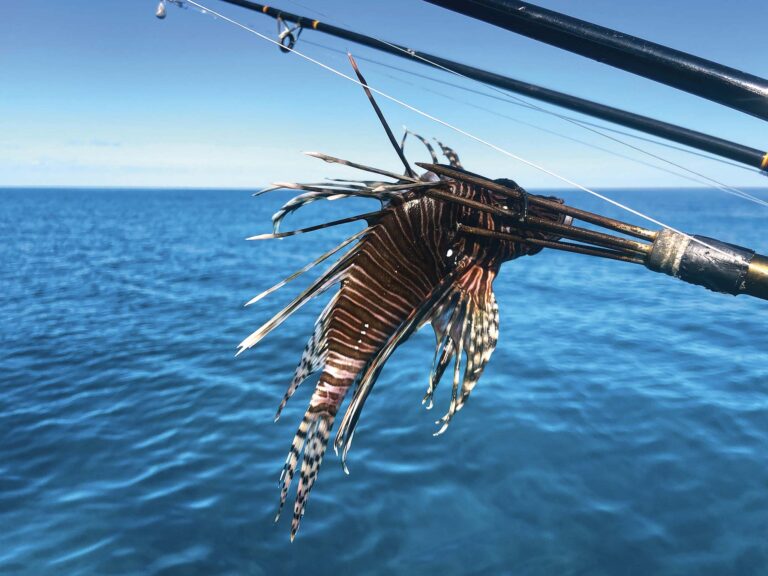
We were sailing in the Indian Ocean from the Seychelles Islands to Madagascar on my brother’s plywood-built 40ft trimaran, Romany Road, a 1,000-mile voyage. It was a clear, calm day far from land. The gentle wind drove us smartly along through the royal-blue ocean.
Out of nowhere, whitecaps began hurrying toward us from the eastern horizon. This made no sense—there should be no whitecaps in 10 knots of breeze in the deep ocean—that is until a white-streaked gray torpedo suddenly leapt into the air and landed with a dramatic splash. Next thing we knew, an immense school of dolphins, hundreds, maybe thousands, were rollicking, diving, streaking through the waves all around us. The fleet leaders crossed our path, swimming on toward God knows where the rest of the school stretching off behind them to the distant horizon. A few chose not to ignore us but paused to play with our boat, zigzagging, twirling, shining, rocketing around us and in between our three hulls before continuing on to wherever it was they were going. An hour later we were alone again, to marvel and reflect.

Romany Road was built on the beach in Pattaya, Thailand, for my brother, Bob, while he was working as an engineer during the Vietnam War. The boat’s accommodations were all in the main hull, the two amas serving to provide stability. Not surprisingly, the combination of Romany Road’s single tall mast, large sail area and shallow draft made for a fast boat.
My brother gladly left Vietnam and the war behind in 1973. First, he did a shakedown cruise of those more peaceful parts of Southeast Asia. After that, he headed across the Indian Ocean to the Seychelles, where my longtime girlfriend, Barbara, and I met him. Gypsy, a brown raggedy Vietnamese street dog, and John, a long-haired Canadian hitchhiker, made up the rest of the crew for the passage to Africa, where our ultimate destination was the Cape of Good Hope.
This being long before the advent of GPS, our navigational tools included a sextant, a chronometer, our trusted pilot book of the Indian Ocean and an RDF, or radio directional finder, (the only, very primitive, marine electronics available to yachtsmen at the time). My brother was adept at taking sights after years as a civil engineer, and our course was just west of south to Madagascar, keeping the Amirante, Farquhar and Comoro islands, which paralleled our course, to starboard.

After three days at sea, we bypassed the Amirantes. That night thousands of stars glowed brightly over the black sea. The wind was still a kindly 10 knots. Wind on the beam, we reached along, our sails white against the immense night sky. At night, algae on the surface of the ocean glowed phosphorescent when disturbed, and a sparkling trail of mini-stars followed our three hulls, glowing up at their larger cousins overhead.
As Bob’s watch was nearing an end, he called me up to take the helm. As he was doing so he also pointed out a pair of dolphins that had reappeared and was now riding in our bow wake. He added that while he’d seen plenty of dolphins before, he’d never seen dolphin behavior like this. There was no playful zigzagging. Instead, they would dart from our starboard ama over to the ama to port, then dive deep and reappear over by the starboard ama again, all in a uniform, businesslike pattern. Each time they left a beautiful trail of phosphorescence going from right to left. Diving deep in tandem, they would disappear briefly, then pop up again to starboard and dart, sparkling, to port side. The pattern never changed. It was always starboard to port, leaving a bright trail behind, then diving and reappearing to starboard, again and again.
Soon afterward, Bob and Barbara, who’d also been on deck laughing and dancing with the dolphins as they streaked across our bows, turned in, and I was alone again in the darkness, accompanied only by our dolphins. I turned on my cassette player at low volume, quiet so as to not disturb my resting shipmates below, thoroughly enjoying myself, listening to the sounds of the Rolling Stones under a canopy of stars.
Suddenly, the dolphins disappeared. Not only did I feel a sense of loss, I experienced a slight unease as well. They had been reassuring. It was then, only another few minutes later, that I saw it—a line of foaming, curling breakers directly ahead, their roar masked by the sound of the music. We were sailing straight into an eggbeater of whitewater at a roughly 45 degree angle, a maelstrom of the kinds of waves you never encounter in the deep ocean, waves you only find breaking on a beach or reef.
Instantly, I yelled for my brother and spun the wheel hard over. At that same moment, though, we were caught by a wave that drove us into the heart of the foam. Up popped Bob, but it was already too late. Another wave hit us. BANG—our port hull hit bottom. Bob immediately hand-cranked the diesel, which roared to life at the same time we hit bottom again with another solid crash. Everyone was now on deck, as Bob steered a course directly into the breakers in the hopes of making it through to the deeper water on the other side. After one more slam, we were able to punch our way free. A deep-keeled monohull would have quickly become stuck and been made a victim of the surf. We had been saved by the fact Romany Road only drew about three feet, which had allowed us to skim over the mysterious reef and back out to sea.
Once safely past, we realized our port ama was taking on water. Disoriented and hearts pounding, we took turns bailing with a ridiculously small bilge pump and buckets to keep it from filling. As we were doing so, Bob took stock of the rest of the boat. His inspection revealed that aside from some bent bolts attached to the small, long blade-like “false” keel in our port ama, we were, mercifully, not taking on water anywhere else. After that, we pumped, took down our sails and waited for the dawn, which when it came revealed a small coral island topped by palm trees in the distance—what could have only been an outlying member of the Farquhar group.
Still safely in deep water, we took turns going into the water to patch our damaged ama. Bob did the lion’s share of the work. As he was doing so, he was surprised by a large visitor. Twenty feet down, slowly rotating in the clear blue, head hanging like an apostrophe, was a large dolphin keeping an eye on him as he worked. The dolphin’s calm presence and watchfulness was reassuring. Sharks are scared of dolphins. Was a dolphin protecting us again? Bob swore the big fella was telling us, “We tried to warn you last night, stupid!”
Meanwhile, the keel bolts remained bent, and our false keel was still hanging at an angle, making it easy for the water to pour in. The bolt holes and a 4in crack running on centerline were the culprits. Lashing a line to the damaged appendage, we unbolted it completely and hauled it on board. After that, we rammed some underwater epoxy into the bolt holes and the long crack as a temporary fix. The repair wasn’t completely watertight, but it got the leak down to a manageable trickle.
Now it was time to figure out next steps. Madagascar was out of the question. We needed to seek shelter and find out just how damaged we truly were. Hands bloody from pumping and getting sliced up by barnacles, we headed in toward the same reef we had grounded on in the darkness, and which had nearly ripped our plywood boat to pieces.

The pilot book warned of a difficult channel into North Island, site of the Farquhar Islands’ only real settlement. Arriving there, we motored in nervously through a break in the reef, small curling waves to port and starboard, passing a half-dozen wrecks to either side on the way in. From there we dodged a series of coral heads as we weaved our way into a crystal-clear blue lagoon. In the end, thanks to our shallow draft, and a lookout on the bow, the channel proved easier than expected.
Dropping the hook in front of the few small buildings that made up the settlement, we rowed ashore where we were greeted by Ronald Sedgewick, the self-proclaimed king of the Farquhar Islands. His official title was plantation manager, but he had pretty much absolute power over the 35 workers who labored there. His “kingdom” consisted of several small, flat islands covered in naturally occurring coconut palms. Ronald was tall, dark, in his mid-50s and quick to laugh. He proved a gracious host. Aside from an annual trip home to the Seychelles to visit his wife and children, he was happy to share his island with his employees, the giant basking sea turtles that liked to visit there and the occasional shipwrecked sailor.
We were much relieved to be within the shelter of the lagoon, where Ronald provided us with a wonderful dinner of fresh fish. When dinner was over, Ronald climbed aboard, and we thanked him with a case of Sey Brew, a beer manufactured by Heineken in the Seychelles. After that, Ronald made himself comfortable at our cabin table, popped a cold one and set about explaining what exactly it was that had happened to.
The Farquhars, he said, are coral islands, low and flat, not like the towering volcanic Seychelles. They are built on and protected by a large reef rising out of the deep ocean, and the tides coming off and on this reef can create strong currents pulling you to or away from the islands. (Alas, there was no mention of this in our pilot book!) In short, Bob’s calculations may have put us well offshore. But in the dark of night, the current’s silent force had bent our path 15 miles off course right onto the reef and near disaster.
Ronald was actually a bit disappointed by how lucky we’d been getting off the reef again so quickly. He stated matter-of-factly that he usually got at least one shipwreck a year, most often amateur adventurers like ourselves. That worked out well for him, he said, because it meant he was able to get more workers for a few weeks or even months until the next supply boat arrived to retrieve them. He was especially disappointed he would lose out on the company of blonde-haired Barbara, an unusual sight in that part of the world. His first question was: “Could she type?” (Remember, this was in the ‘70s—the world has come a long way since!)
By now it was painfully obvious what our determined dolphin friends had been trying to tell us. For three hours they had repeatedly provided us with a phosphorescent arrow, telling us to steer to port to avoid crashing into the reef, only abandoning us when they would’ve had to join us among the breakers. If we had been better in tune with our environment and understood their persistent signal, it would have saved us from our near disaster.
Ronald stayed well past midnight, swapping sea stories. Our dolphin story amazed him. Finally, we turned in, as Ronald’s brother-in-law kept an eye on the water level in our wounded float.
So much for catching up on some sleep. At 0500, Ronald hailed us from his small boat. “Follow me. We have to catch the tide,” he said and guided us through yet more coral heads around to a beautiful sandy beach where we would be able to set our shallow-draft vessel in the sand and make our repairs. Ronald promised he would return at high tide to guide us back to the settlement.

As the water receded, we set to work while Gypsy bounded for joy, happy to be back on solid land again, filling the cracks and bolt holes in Romany Road’s port ama, and making our craft ocean-ready again. We also took the opportunity to clean Romany Road’s hulls, scrapping away the barnacles and marine growth that begun slowing us down. One positive out of our near-disaster: we would be all the faster through the water when it came time for us to be on our way again.
Soon afterward, the tide slowly returned and with it came a small school of rays glided by at our feet. Curious, they surrounded our craft and her wading sailors. We, in turn, marveled as they streamed around us, elegantly flapping their wings above the golden sands, their wings spanning three feet and more.
As promised, Ronald also returned with the tide. Our repair work done, Romany Road floated free with clean hulls and a disappointed dog not nearly ready to return to sea. We followed our savior back to the anchorage, and after guiding us in he tossed us another wonderful fish in farewell and then turned his boat toward shore. We bid him a fond adieu. The next morning, we all agreed, we needed to be sailing again. Time was short. Our weather window for getting around the Cape of Good Hope meant we had to keep moving.
That night, relieved and resting safely at anchor, we fell into the sleep of kings. Finally, in the morning, after securely lashing our false keel on deck (reattaching it again would require the resources of a larger port) we waved goodbye to Ronald and headed back out through the break in reef, which no longer seemed half so frightening as it had making our way in.
Years later, I read The Long Way, by Bernard Moitessier, the famous, and some say mad solo circumnavigator. As fate would have it, he had the exact same experience off New Zealand, with a warning dolphin creating a similar arrow pattern. Like us, he ignored the warning and ran his boat right up onto a reef. Like us, he was also lucky. He and his steel boat survived to continue his world-famous passage.
So, what have we learned? Basically, that we humans are not as smart as we think we are. It would behoove us to be more in tune with the world as a whole and able to learn from others, including other species.
Photos courtesy of John Platt
March 2021









